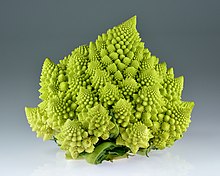Romanesco broccoli
| Romanesco | |
|---|---|
 Romanesco, showing its self-similar form | |
| Species | Brassica oleracea |
| Cultivar group | Botrytis cultivar group |
Romanesco broccoli (also known as broccolo romanesco, romanesque cauliflower, or simply romanesco) is in fact a cultivar of the cauliflower (Brassica oleracea var. botrytis), not a broccoli (Brassica oleracea var. italica).[1] It is an edible flower bud of the species Brassica oleracea, which also includes regular broccoli and cauliflower. It is chartreuse in color and has a striking form that naturally approximates a fractal.[2] Romanesco has a nutty flavor and a firmer texture than white cauliflower or broccoli when cooked.[3][4]
Description
[edit]


Romanesco superficially resembles a cauliflower, but it is chartreuse in color, with the form of a natural fractal. Nutritionally, romanesco is rich in vitamin C, vitamin K, dietary fiber, and carotenoids.[5]
Fractal structure
[edit]The inflorescence (the bud) is self-similar in character, with the branched meristems making up a logarithmic spiral, giving a form approximating a natural fractal; each bud is composed of a series of smaller buds, all arranged in yet another logarithmic spiral. This self-similar pattern continues at smaller levels. The pattern is only an approximate fractal since the pattern eventually terminates when the feature size becomes sufficiently small. The number of spirals on the head of Romanesco broccoli is a Fibonacci number.[6]
The causes of its differences in appearance from the normal cauliflower and broccoli have been modeled as an extension of the preinfloresence stage of bud growth.[7] A 2021 paper has ascribed this phenomenon to perturbations of floral gene networks that causes the development of meristems into flowers to fail, but instead to repeat itself in a self-similar way.[8][9]
See also
[edit]References
[edit]- ^ Azpeitia, Eugenio; Tichtinsky, Gabrielle; Masson, Marie Le; Serrano-Mislata, Antonio; Lucas, Jérémy; Gregis, Veronica; Gimenez, Carlos; Prunet, Nathanaël; Farcot, Etienne; Kater, Martin M.; Bradley, Desmond (2021-07-09). "Cauliflower fractal forms arise from perturbations of floral gene networks". Science. 373 (6551): 192–197. Bibcode:2021Sci...373..192A. doi:10.1126/science.abg5999. hdl:10251/182273. ISSN 0036-8075. PMID 34244409. S2CID 235769692.
- ^ Cathy Wilkinson Barash (1998). Kitchen Gardens: How to Create a Beautiful and Functional Culinary Garden. Houghton Mifflin Harcourt. p. 42. ISBN 0395827493.
- ^ Marie Iannotti (2012). The Beginner's Guide to Growing Heirloom Vegetables: The 100 Easiest-to-Grow, Tastiest Vegetables for Your Garden. Timber Press. ISBN 9781604691887.
- ^ James Briscione; Brooke Parkhurst (2018). The Flavor Matrix: The Art and Science of Pairing Common Ingredients to Create Extraordinary Dishes. Houghton Mifflin Harcourt. p. 46. ISBN 9780544809963.
- ^ Tufts Nutrition. "Tufts Nutrition Top 10". Tufts Nutrition Magazine. Retrieved 26 February 2020.
- ^ Ron Knott (30 October 2010). "Fibonacci Numbers and Nature". Ron Knott's Web Pages on Mathematics. Archived from the original on 28 November 2018.
- ^ Martin Kieffer; Michael P. Fuller; Anita J. Jellings (July 1998). "Explaining Curd and Spear Geometry in Broccoli, Cauliflower and 'Romanesco': Quantitative Variation in Activity of Primary Meristems". Planta. 206 (1): 34–43. doi:10.1007/s004250050371. S2CID 39949892.
- ^ Azpeitia, Eugenio; Tichtinsky, Gabrielle; Masson, Marie Le; Serrano-Mislata, Antonio; Lucas, Jérémy; Gregis, Veronica; Gimenez, Carlos; Prunet, Nathanaël; Farcot, Etienne; Kater, Martin M.; Bradley, Desmond (2021-07-09). "Cauliflower fractal forms arise from perturbations of floral gene networks". Science. 373 (6551): 192–197. Bibcode:2021Sci...373..192A. doi:10.1126/science.abg5999. hdl:10251/182273. ISSN 0036-8075. PMID 34244409. S2CID 235769692.
- ^ Farcot, Etienne. "Why do cauliflowers look so odd? We've cracked the maths behind their 'fractal' shape". The Conversation. Retrieved 2021-07-20.
External links
[edit] Media related to Romanesco broccoli at Wikimedia Commons
Media related to Romanesco broccoli at Wikimedia Commons The dictionary definition of Romanesco at Wiktionary
The dictionary definition of Romanesco at Wiktionary
- Malatesta, M.; Davey, J.C. (1996). "Cultivar Identification Within Broccoli, Brassica Oleracea L. Var. Italica Plenck And Cauliflower, Brassica Oleracea Var. Botrytis L.". Acta Hortic. 407 (407): 109–114. doi:10.17660/ActaHortic.1996.407.12.
- Fractal Food: Self-Similarity on the Supermarket Shelf (John Walker, March 2005)
- Procedural fractal 3-D generation of Romanesco broccoli with RenderMan (Aleksandar Rodić, 2009)
